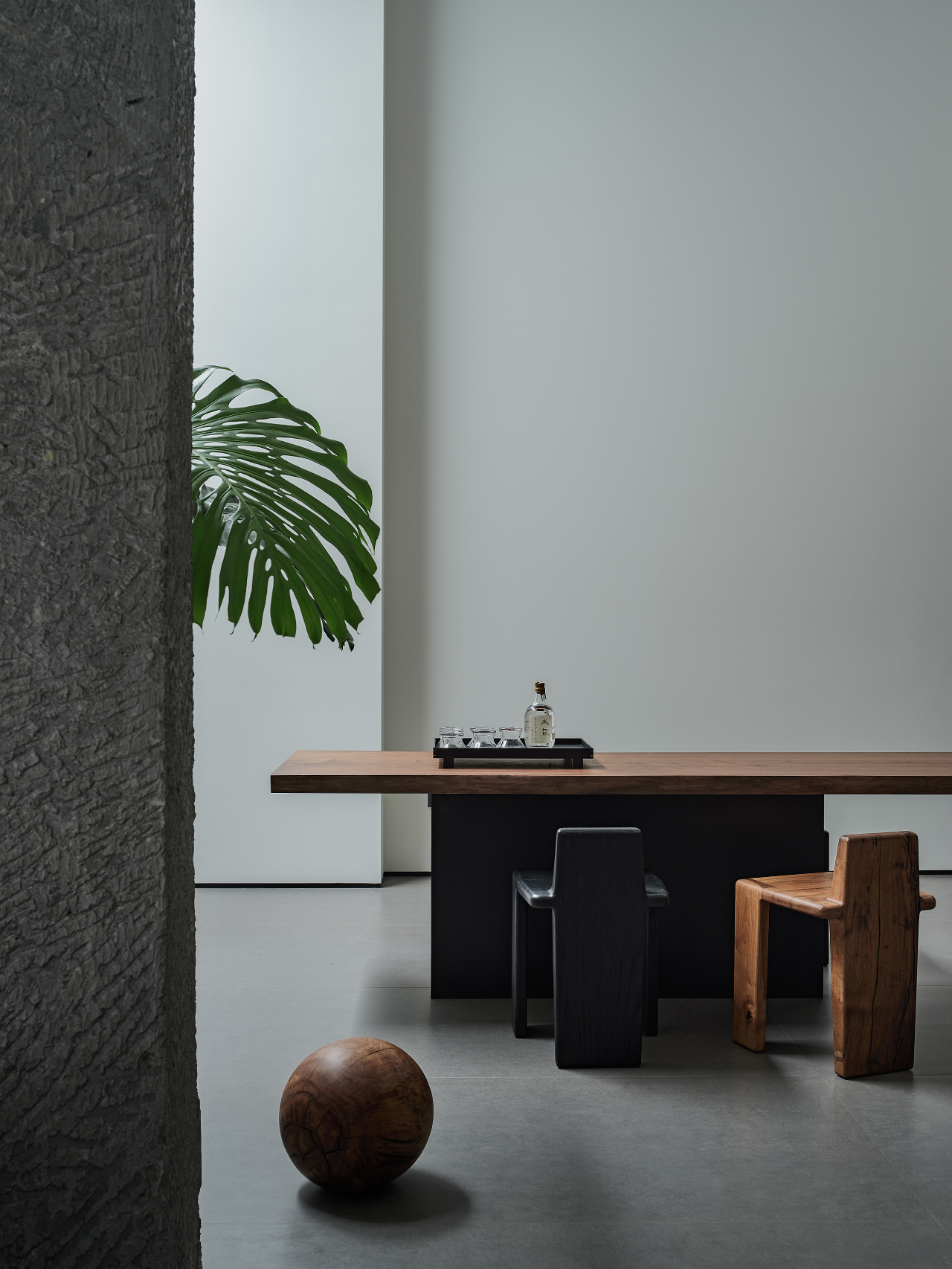Lost Villa Boutique Hotel in Yucun NATURALBUILD
2018-02-06 22:00
View Westwards the Platnaus Tree. Image © Hao Chen
向西看桔梗树。形象名:郝晨


架构师提供的文本描述。该项目位于浙江省莫干山玉村一家国有蚕场的西南角,通过一条山路与莫干山山顶相连。该网站可以从西北角进入,地形由北向南逐渐降低。那里有一些小屋,北面有锯齿状的轮廓,而南端则可以看到蜿蜒小溪的全景。
Text description provided by the architects. Located at the southwest corner of a previously state-owned silkworm farm in Yucun, Moganshan, Zhejiang Province, the project is connected to the peak of Moganshan Mountain by a mountain trail. The site can be accessed from the northwest corner and the terrain is gradually lowered from the north to the south. There are cottages standing adjacent with jagged outline on the north, whereas the southern end opens up to a panoramic view of a meandering stream.
Street View From North Side. Image © Hao Chen
北边的街景。形象名:郝晨




历史遗留下来的土地所有权在邻里形成不规则的边界。现有的老建筑散落在地上,其中一些甚至倒塌;一所废弃的小学矗立在河的另一边,前景仍不明朗;树木填补了农村织物中剩余的空隙。这是当代中国农村的典型景观条件,既有异质性,又有动态性。
The historical legacies of lands ownership in neighborhood shape the irregular boundary of the site. Existing old buildings scatter on the ground, some of which have even collapsed; an abandoned primary school stands on the other side of the river, whose prospects still remain unknown; trees fill up the left over voids among the rural fabrics. This is the typical landscape condition of contemporary Chinese rural area, both heterogeneous and dynamic.
Roof Lounge Chair and the Pool. Image © Hao Chen
屋顶休息室椅子和游泳池。形象名:郝晨


因此,设计受到限制,同时受到动态的当前和不可预测的前景的驱动。景物内化的策略,不仅建立了抵御不利环境的防御姿态,而且将饱和的内部空间转化为景观的一部分。
The design is therefore constrained and as well motivated by both the dynamic present and the unpredictable prospects. The strategy of internalizing scenery, not only establishes a defensive gesture against the unfavorable surrounding conditions but also turns the saturated inner space into part of the landscape.
Café Courtyard Old Trees and Distanced Mountain. Image © Hao Chen
咖啡厅庭院古树和遥远的山。形象名:郝晨


同时,该设计还为当地居民提供了一系列公共节目,如咖啡厅(与酒店分开的入口)、小展区和三楼的餐厅。节目的安排创造了独特的公共空间和酒店区域之间的循环,以及各种各样的长廊体验。
At the same time, the design provides a series of public programs for the locals, such as the café (with its own separated entrance from the hotel), the small exhibition area and the restaurant on the third floor. The arrangement of programs creates a unique circulation between public space and hotel area, and various promenade experience.
Different Openings and Light. Image © Hao Chen
不同的开口和灯光。形象名:郝晨


大部分客房被指定进入主建筑的南部,以获得充足的阳光和花园的全景风景。在西端,有一个圆木和一个游泳池,其中框架的主要入口,并创建一个周边,以缓冲网站从主干道。
Most of the guestrooms are designated into the southern part of the main building to obtain sufficient sunlight and panoramic scenic views of the garden. At the west end, there are a loggia and a swimming pool, which frame the main entrance and create a perimeter that buffers the site from the main road.
Analysis of Different Guestrooms and Window Views. Image Courtesy of Naturalbuild
不同客房和窗口景观的分析。自然建筑的形象礼貌


Interior View of Guestroom. Image © Hao Chen
客房内景。形象名:郝晨


与主楼一起,洛贾形成了一个开放的后院区域,只为酒店客人服务。至于东端的那栋楼,那是一座独立而幽静的别墅,可以租给一家人。
Together with the main building, the loggia forms an open backyard area that serves only hotel guests. As for the building on the east end, it is an independent and secluded villa that can be rented out to an entire family.
View Under the Roof of Loggia. Image © Hao Chen
洛贾屋顶下的景色。形象名:郝晨


Volume and Program Arrangement. Image Courtesy of Naturalbuild
音量和程序安排。自然建筑的形象礼貌


利用该网站百年历史的樟脑树和普拉塔努斯树,甚至遥远的山脉,设计框架场景,创造了一系列动态的建筑景观。框架景观与每个房间的布局有着不同的相互作用,并使每个房间的规划与窗口之间的关系多样化。
Taking advantage of the site’s hundred-years-old Camphor and the Platanus tree and even the distanced mountains, the design frames scenes to create a sequence of dynamic views from the building. The framing scenery interacts differently with the layout of each individual room, and diversifies the relationships between each room’s plan and the window.
Analysis of Views Facing the Camphor Tree. Image Courtesy of Naturalbuild
面对樟树的观点分析。自然建筑的形象礼貌


Large Window View Towards the Old Camphor From VIP Table in Restaurant. Image © Hao Chen
从餐厅的VIP桌看到老樟脑的大窗口。形象名:郝晨


设计在强调规划布局和室内景观的拓扑作用的同时,停留在具体性的层次上,使战略思维超越了概念。最终,设计呈现出一种更自然的姿态。
While the design emphasizes the topological play of the programmatical layout and the interior scenery, it stops at the level of specificity, allowing strategic thinking surpass the concept. Eventually, the design presents a more natural gesture.


设计的结构体系是混合砌体结构和木钢桁架的混合结构,能够在预算和美学之间取得平衡。该设计旨在实现一种光学精度,而不是建筑细节的精确性,而是创造细节与背景景物之间的对话。一方面,详细设计过程是针对我国农村建设中遇到的典型问题,即建筑质量差、基础设施不足、产品供应有限等问题而设计的。
The structural system of the design is a hybrid of mixed masonry structure and wood-and-steel-trusses, which is able to strike a balance between budget and aesthetic. The design aims to achieve a type of optical precision, which is not about the precision of construction details, but, on the contrary, about creating a dialogue between the details and their background scenery. On the one hand, the detail design process aims to respond to such typical problems that one encounters when building in rural China.This includes poor construction quality, the lack of infrastructure and limited product supply.
Exterior View From North Side of Hotel Lobby. Image © Hao Chen
酒店大堂北侧的外部景观。形象名:郝晨


这包括建筑质量差、基础设施缺乏和产品供应有限。正是通过我们(设计师)、预制供应商和当地工匠在整个设计和开发过程中的密切协作,这些问题才得以解决。
This includes poor construction quality, the lack of infrastructure and limited product supply. It is through an closely collaborative process that operated throughout the entire design and built development between us (the designers), prefabrication suppliers and local craftsmen that these respective issues are resolved.
Interior View of Hotel Lobby. Image © Hao Chen
酒店大堂内景。形象名:郝晨


一系列的钢/木窗和门系统,内部胶合板门,超大的自动窗口,以及一系列定制的灯具和家具,都是这项合作努力的产物。另一方面,细节设计是对不可避免的施工误差和局部约束突变的反应。因此,这些偶然的问题在现场引发了一系列的即兴设计。
A series of steel/wood window and door systems, interior plywood doors, extra large automatic window as well as a series of customized light fixtures and furniture are all the product of this collaboration effort. On the other hand, the detail design is otherwise the reaction to the inevitable construction errors and the sudden changes of local constraints. As a result, these accidental issues induce a series of improvisational designs on site.
View of River Landscape and The Buildings From the Southeast. Image © Hao Chen
江河景观及东南地区的建筑景观。形象名:郝晨






























































































Architects NATURALBUILD
Location 85 Huangfu W Rd, Moganshan Zhen, Deqing Xian, Huzhou, Zhejiang, China
Lead Architects Yanfei Shui, Yichi Su, Yuanrong Ma
Project Architects Dan Deng, Hanhua Xu
Project Team Gege Li, Jing Sun, Xini Chai, Xiaoyan Zhou, Keyi Wang, Hao Chen, Linlin Luo, Zhuoran Chen, Lijin Zhu, Ying Zhu
Area 1491.0 m2
Project Year 2017
Photographs Hao Chen
Category Hotels
























